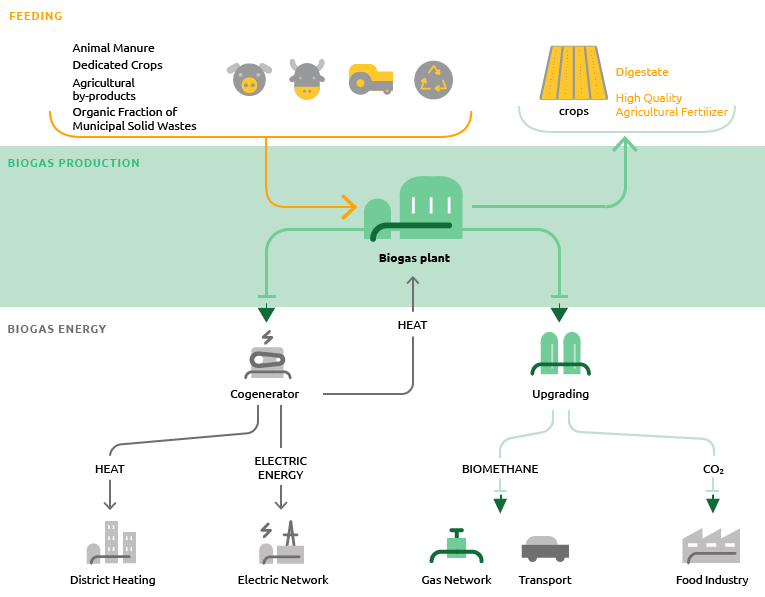Biomethane: A currently reality and opportunity for the future
Biomethane is a renewable, flexible, efficient and programmable source, also thanks to existing transport and storage infrastructures, which are perfectly and totally integrated with other renewable sources like solar and wind energy.
14
connection
agreements
were concluded in 2018 for
the injection of biomethane
Dedicated plants produce both agricultural and agro-industrial by-products from anaerobic digestion and organic fraction of waste through a biogas upgrading process.
Biomethane can already be injected into the network and used in all sectors where the gas is present. Because it is a renewable energy, on March the 2nd 2018 the Italian government issued a Ministerial Decree which promotes the use of biomethane as a fuel for road transportation.
The biomethane cycle

Biomethane has many different advantages:
- A perfect example of the circular economy: both in the field of agriculture, agro-industry and with regard to the management of the organic fraction of municipal solid waste (FORSU), biomethane is produced through waste products and by-products which, once the anaerobic digestion process is completed, are used as totally natural fertilizers capable of restoring the necessary organic substances and nutrients to the soil from a circular economy perspective.
- An efficient, flexible and programmable energy source: the production of biomethane is per se inflexible and non-programmable; however, the presence of infrastructure such as gas transportation networks and storage facilities ensure that, unlike other renewable energies, once it has been injected into the Snam network, the consumption of biomethane can be modulated as needed without requiring additional investments;
- Totally renewable and sustainable: despite being a gas, biomethane is considered a neutral source from the perspective of greenhouse gas emissions and it is totally renewable since its production takes place through the transformation of waste and organic material which in any case would produce greenhouse gas emissions. In addition, it is acknowledged that for biomethane from agricultural sources, the carbon dioxide emissions produced during combustion are the same as the quantity of carbon dioxide absorbed by crops when growing, rendering the process neutral from an emissions point of view. The process can become “negative” from “neutral” if the carbon dioxide produced and separated during the biogas upgrading phase is used for industrial and/or food purposes. In addition, the production of biomethane does not compete with the production of food and promoting the use of particular “second harvest” energy crops it makes it possible to maintain the agricultural balances of the existing economy;
- It creates value for local communities: biomethane can be the source of a new economy at a local level, creating jobs, increasing tax revenues for local communities, answering to the needs of disposing and exploiting the organic fraction of urban waste and, through particular cultivation techniques; it also fights the effects of desertification, preserving and sometimes restoring specific soil nutrients;
- It minimises the costs of decarbonisation: biomethane becomes a fundamental source to achieve national and European objectives in terms of decarbonisation, as new investments in infrastructure are not required and helping to use waste and by-products.
Snam supports the Italian biomethane chain and will invest at least €100 million in this business segment by 2022. In addition to the previously mentioned acquisitions (IES Biogas and Enersi), in the biomethane production and distribution sector, Snam and BHGE (Baker Hughes, a GE Group company) signed an agreement in 2018 aimed at creating four micro-liquefaction plants in Italy. These plants will also be capable of liquefying biomethane produced from renewable sources and transforming it into bio LNG (Liquefied Natural Gas), which will then be used in the heavy road transport sector and to promote the expansion of this technology to sea transport in Italy.
The Consorzio Italiano Biogas (CIB) estimated a biomethane production potential in Italy of 10 billion cubic metres by 2030, 80% of which will be produced from agricultural origins. If used entirely in the transport sector, biomethane would guarantee the possibility of running a third of all the vehicles in Italy with renewable energy, which could rely on a distribution network of around 1300 facilities constantly increasing. In Italy the opportunities of exploiting and developing more the sustainable mobility have also been confirmed by what was established in the new Interministerial Decree of March the 2nd 2018, which promotes the use of bio-fuels and biomethane in the transport industry, in line with the provisions of the EU Directives promoting renewable energy sources and reaching the targets set for bio-fuels to be used in the transport sector. By 2020, 10% of the fuel used in the transport sector in EU countries should be renewable.